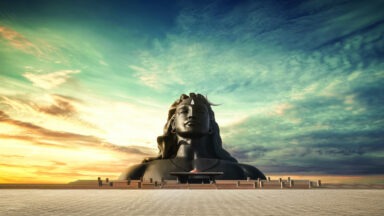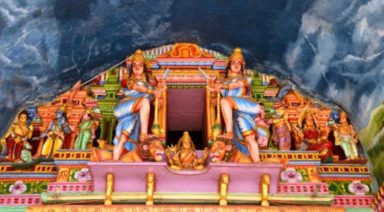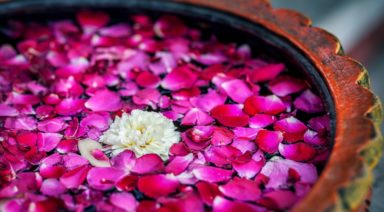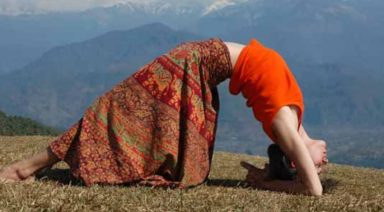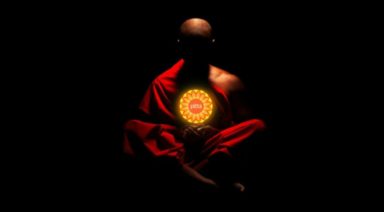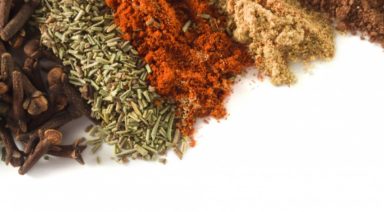Inviting the Fierce Feminine Mother Kali Into Your Life
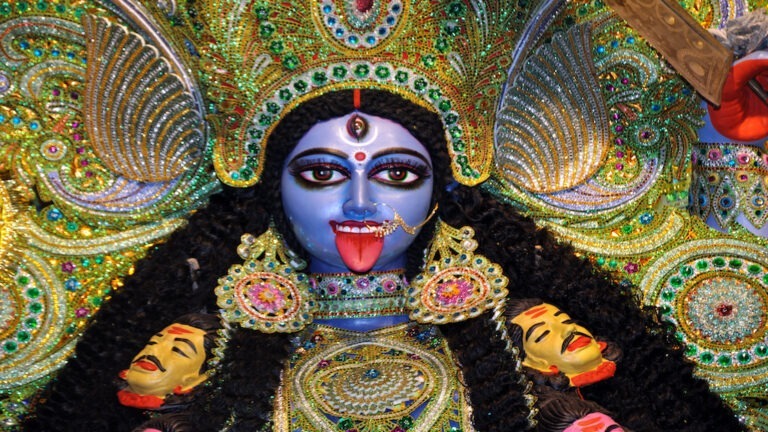
I am particularly fond of participating in or teaching classes themed around the Goddess Kali. Creating an invitation for Kali to enter our life is a way to invite fierceness into our being. She is the powerful and ferocious energy of the feminine mother.
Kali is often referred to in Hindu mythology as the dark goddess, the goddess of doomsday, the goddess of time, and the goddess of death. But once we delve deeper into what she really stands for, we see beyond this doomsday classification. She is ferociously powerful, and in her power, she is the fierce representation of motherly love; a mother’s bold and fiery force of love, as well as her innate desire to protect and support her children.
Kali is a form of Shakti or the feminine universal energy that motivates creativity and fertility. She is also an incarnation of Parvati, the Earth Mother (first wife of Shiva of the Holy Trinity). In this way, she also becomes a feminine counterpart to Lord Shiva, the God of Destruction. Her name has been translated as ‘she who is black’ or ‘she who is death.’
Many of the depictions of Kali show a warrior goddess to be feared. She is often seen wearing a necklace of chopped-off heads and a skirt of severed arms. She wields a knife dripping blood in one hand, holds a decapitated head in the other, and has a red lolling tongue dripping with blood.
As the goddess of time, Kali embodies the true nature of time. She demonstrates how time eventually absorbs all things. She is the ending to the beginnings and middles. Remember also that every ending holds a void of space, or nothingness, and from the space of nothingness, bright new beginnings are generated.
Kali and Durga
One of my favorite anecdotes of how Kali was born relates to the goddess Durga. Durga had initially been created in the likeness of the Holy Trinity, and therefore possessed certain talents of Brahma, Vishnu, and Shiva. She was created to help overcome the forces of evil attacking the Universe, including Mahishasura, the evil buffalo demon.
Durga was fighting a losing battle. Despite the fact her eight arms brandished a variety of weapons used in battle, Mahishasura was winning. Each time Durga stabbed or slew him and spilled his blood, Mahishasura became gremlin-like, multiplying with water. His blood would spill, and each droplet would form into another warrior demon to help him defeat Durga.
Durga got angrier and angrier and her brow began to furrow before she slipped into a moment of her greatest rage. From her brow and from her third eye, the anger spilled out onto the battlefield. Durga’s anger began to form into the shape of the dark blue-black hues of the goddess Kali.
As she manifested from Durga’s point of greatest rage, Kali used the energy of anger to her advantage. She summoned it to help with the multiplying demons in front of her, needing to figure out a way to stop spilling their blood.
Kali popped one demon into her mouth. ‘Not bad,’ she thought. ‘Tastes like chicken…’ Luckily she was a goddess with a good appetite and continued to eat demon after demon-like popcorn—WHOLE demons so as not to spill any more blood. She worked efficiently and tirelessly until the demons were gone and her belly felt full. In this way, Kali helped Durga win the battle against Mahishasura!
Kali and Shiva
But it doesn’t stop there. Kali was on a roll. The blood of the demons was slightly addictive, so she went into an undiscerning feeding frenzy. She was flying high on demon blood, and although they had been diminished, she wanted more. She stuck out her tongue, dripping with blood, and licked her lips while she looked around for her next snack.
Kali grabbed and grasped at everything around her and started stuffing it into her mouth. She was eating foliage, unlucky animals, and anything else she could find. In her feeding madness, she was also destroying everything exceptional and valuable.
Kali continued in her whirling dance of consumption. The gods and goddesses became alarmed and had no idea how to get Kali to stop her destructive, bloody rampage. They called upon Shiva, the masculine counterpart to Kali, and asked him to help.
It’s all about balance. There is dark and light, the sun and the moon, the masculine and the feminine. Shiva saw Kali in her unbalanced, blinded, and out-of-control state and realized she needed to be pulled back towards a more equitable frame of mind.
Shiva laid himself down on the battlefield and anxiously waited for Kali to get closer, hoping his idea would work. Kali swirled around in her frazzled state, still eating anything and everything in sight. She danced and twisted closer to Shiva. Close enough for her footfall to land on Shiva’s chest.
The moment Kali felt Shiva was the moment she was brought back to a more harmonious way of being. Shiva was her masculine equivalent and he reined her back to reason. He was familiar and comforting enough to finally calm Kali from her ruinous actions. As a consequence of this story, many battlefields and cremation sights have an association to the goddess Kali.
How to Embody Kali
When practicing physical postures to call in Kali, begin in goddess or temple pose. Feel the balance of both strength in the legs and fierce softness in the heart. Clasp your hands into a steeple grip, then release the index fingers to a point. This is called Kali Mudra.
Extend your Kali Mudra overhead by straightening your arms. Take a huge breath in through your nose. Exhale from an open mouth while you slice your straight arms with Kali Mudra down and in front of you towards the pelvis. Exhale loudly and send it out of the body as much as possible. While you exhale, look gently towards your third eye. Mimic Kali by sticking your tongue out as far as you can.
If you like adding a silent mantra or a phrase to your efforts, use the following to evoke her essence:
OM SRI MAHA KALIKAYAI NAMAHA
or
I AM FIERCELY POWERFUL / LOVING
Asking Kali to infiltrate your life when you need her requires a fierce and unrelenting temperament. Be a mother figure who vehemently defends and protects her child, whatever you might consider as your child. Learn to speak ‘no’ with a strong commitment to your boundary. Stop apologizing for so many things. Only apologize for what deserves an honest ‘sorry.’
Instead of being scared, insecure, and asking so many questions based on a fear of messing things up, take action based on your knowledge, understanding, and trust in what you DO know. Learn how to be unapologetic and unwavering in who you are. Ask for what you want. Embrace your individuality.
Ridding Your Negative Personal Narratives With Lord Shiva
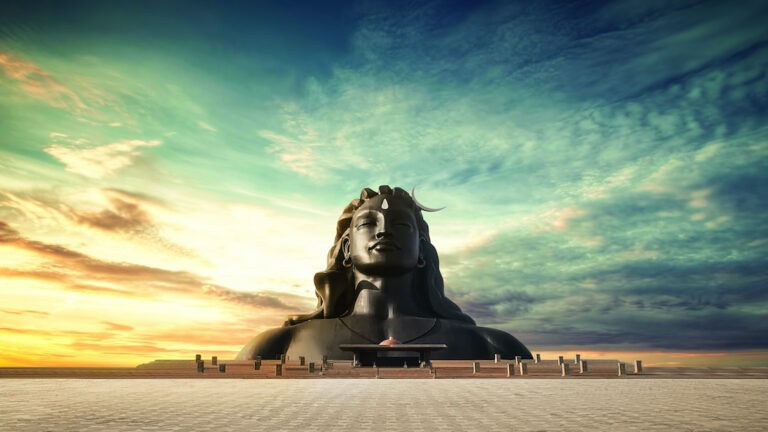
Lord Shiva is a well-known and worshipped Hindu deity. He is one of the Holy Trinity (the Trimurti), which consists of Lord Brahma, Lord Vishnu, and Lord Shiva. What each represents in our familiar terms are brand new beginnings (Brahma), the middle of everything in existence (Vishnu), and the endings (Shiva). When Shiva, as the Lord of Dissolution, gives us the endings, he also provides the space for Brahma to instill a bright new beginning. It is from the void of nothingness, or space, left after something comes to an end, that Brahma responds by bringing the start of something new.
Shiva, Lord of Dissolution
Shiva, The Auspicious One, is also known as Mahadeva or The Great God. He is worshipped as the Supreme Being in Shaivism, a major institution within Hinduism. I like to explain the concept of endings giving way to brighter new beginnings with the metaphor of a bookshelf filled with storybooks that represent our own considerations about ourselves.
Imagine you have a large bookshelf in your mind. The bookshelf is jam-packed with books whose titles represent your own self-judgments or concepts of yourself. One thing to mention is that we are constantly in judgment of ourselves. We are usually in judgment of something and judgments can be good or bad. For instance, we might see a book entitled ‘I am a great Mother,’ or ‘I am a giving person.’
Conversely, we have the debilitating narratives. ‘I am unworthy’ or ‘I am not flexible enough’ as some of the titles we’re experiencing. But the debilitating narratives are simply opportunities to grow or bring Shiva into our lives.
Shiva comes along as the Lord of Dissolution; he shows us where we are hindering our growth with certain stories or ways of being. For instance, when you decide you are fed up with thinking of yourself as unworthy, or not good enough, Shiva gives you the willpower to dissolve that story. The ‘I am unworthy’ book gets removed from the shelf and thrown to the wayside.
What is left behind is an open space, an open space ready and willing to house a new book with a new title. Brahma steps in and gives us the capacity to formulate a new storybook title that feels brighter and shinier as a new beginning, or judgment of self. For example, we switch from the ‘I am unworthy’ mantra to ‘I am good enough.’ In this way, Shiva and Brahma give us the ability to challenge our belief system and change it for self-betterment.
Shiva, Lord of Dance
A common depiction of Shiva is one of a dancing four-armed deity. In this form, Shiva is known as Nataraja, or the Lord of Dance. He is seen dancing in a halo of fire which represents samsara, or ‘flowing around.’ In his upper right hand, Shiva holds a hand drum said to have drummed the first drum beats to help create everything, paired with the sound of “Om.”
His upper left hand holds a flame said to have the ability to destroy on behalf of transformative new beginnings. His bottom lower right hand holds abhayamudra, a gesture used to convey fearlessness. His bottom left hand mimics the lifted position of his left leg. This symbolizes a respite soul’s find from the earthly troubles on a path towards soul liberation. His lifted left leg is a journey towards this elevated consciousness. Finally, the snake he wears around his waist is the creative energy that exists in our psychic body.



